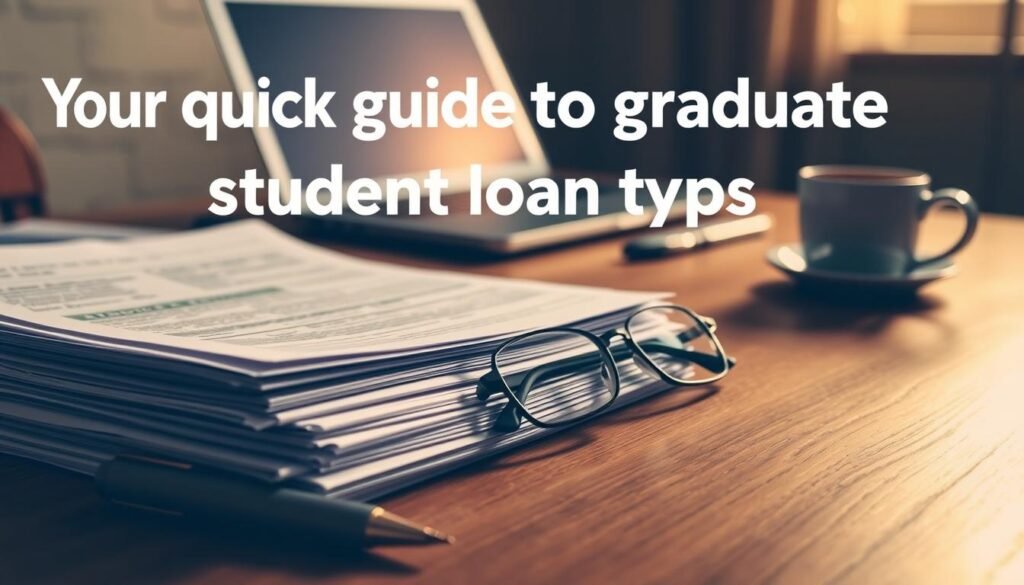
Discover Your Private Loan Options for Graduate Students

Can a simple funding choice change how you handle grad school costs? Many students find federal aid falls short of tuition, books, and living expenses. You may need extra funds to bridge that gap.
You’ll learn how to use federal aid first, then compare lenders to fill remaining needs. That process helps protect your credit and your budget. We’ll show which lenders offer high amounts, fee-free terms, and degree-specific programs.
Expect clear steps to estimate the amount you need, see how schools certify funds, and understand what affects your interest and final rate. You’ll also get tips on cosigner release, repayment choices, and service quality so you can pick a path that fits your timeline and goals.
- Start here: How private loan options for graduate students fit with federal aid today
- Your quick guide to graduate student loan types
- Best private loan options for graduate students by situation
- How to compare lenders like a pro
- Spotlight on Ascent: Pre-qualification to funding, step by step
- Eligibility basics you should confirm before you apply
- Degree-specific private graduate student loans
- International and DACA borrowers: Your paths to graduate student loans
- Smart repayment moves: Rate type, timing, and forgiveness considerations
- Put your plan into action: Compare, pre-qualify, and choose your best-fit lender
Start here: How private loan options for graduate students fit with federal aid today
Prioritize federal borrowing first; then weigh outside offers for larger coverage or better rates. Start with Direct Unsubsidized and Grad PLUS so you keep federal repayment protections and possible forgiveness paths.

Why you max out Direct Unsubsidized before going private
Direct Unsubsidized gives predictable fixed interest rates and broad repayment protections with no credit check. You may borrow up to $20,500 per year, though your school sets your actual eligibility.
This is your most flexible first layer because it has a fixed 7.94% rate and a 1.057% fee. Graduate borrowers aren’t eligible for subsidized help, so this becomes primary federal aid.
When Grad PLUS beats private and when it doesn’t
Grad PLUS covers up to your certified cost attendance minus other aid, but has a higher fixed 8.94% rate and fees above 4%. It requires a credit check and reviews adverse credit history.
If you plan on public service or need income-driven repayment and PSLF eligibility after 120 payments, Grad PLUS can outperform external offers. If you have strong credit or a solid cosigner, a nonfederal lender may offer lower rates and fees so compare total cost, fees, and repayment flexibility before you decide.
Your quick guide to graduate student loan types
A quick comparison helps you weigh federal benefits against market rates and fee structures. This snapshot will make it easier to pick a path that matches your credit profile and cash flow needs.
Federal Direct Unsubsidized vs. Grad PLUS at a glance
Direct Unsubsidized offers a 7.94% interest with a 1.057% origination fee and a $20,500 annual cap. It has predictable interest rates and broad repayment choices, though annual limits can leave gaps.
Grad PLUS carries an 8.94% interest and fees above 4%. It covers up to your certified cost attendance minus other aid but requires a credit check and may raise total borrowing costs.

Private loans: fixed vs. variable interest rates
Nonfederal lenders set rates by credit and cosigner strength. Fixed rates give steady monthly payments. Variable interest can start lower but may rise, which affects your long-term budget.
- Origination fee differences change your true cost: 1.057% vs. >4% matters over time.
- Choose a loan term that matches your repayment plan; shorter terms cut total interest but raise monthly payments.
- Look at repayment terms: interest-only or in-school payment options can limit balance growth while you study.
Best private loan options for graduate students by situation
Match lenders to your profile: some offer huge caps, some favor top credit, and others cut fees and cosigner needs. Pick what matters most and align it with your repayment timeline.
Need high amounts
Citizens Bank can fund up to $350,000, while College Ave and Sallie Mae may cover 100% of your certified cost of attendance. These choices suit high-cost programs that need a large amount.
Strong score advantage
EdvestinU rewards top applicants but requires a 750 minimum credit score and $30,000 minimum income. It offers higher autopay discounts and a clear path to cosigner release after 36 on-time payments.
No-fee, flexible terms and cosigner paths
Ascent has no application, origination, or disbursement fees on college products. Terms range 5–20 years, some paths avoid a cosigner, and a 1% graduation cash-back reward may apply.

| Lender | Max amount | Key perk | Cosigner release |
|---|---|---|---|
| Citizens Bank | $350,000 | High coverage for expensive degrees | Varies by product |
| College Ave | 100% COA | Flexible in-school payments | Typical release after set payments |
| Sallie Mae | 100% COA | Broad program coverage | Varies by borrower history |
| EdvestinU | Depends on credit | Best rates with high score | 36 on-time payments |
| Ascent / INvestEd / MEFA | Up to COA | No fees / state perks / 15-yr term | 12–48 payments, varies |
Quick tip: weigh interest rates, origination fee impact, and repayment terms. If you want a clear comparison, compare lenders to find the best match for your credit and program.
How to compare lenders like a pro
Start by lining up lender quotes so you can see true cost differences side by side. Focus on total APR, not just the advertised rate. That reveals how an origination fee or discounts change what you pay.
Rates, fees, and total cost
Compare advertised interest rates and add any origination fee to get real APR. Note autopay discounts and graduation rewards that lower monthly bills.
Eligibility and credit checks
Check each lender's stated minimum credit score and income rules. Use soft pre-qualification where possible to avoid hard pulls on your credit.
Repayment choices and cosigners
Review repayment terms and in-school payment choices like interest-only or deferred payments. Confirm cosigner requirements and the timeline to request cosigner release after on-time payments.
| Compare Point | What to check | Why it matters |
|---|---|---|
| Rate type / APR | Fixed vs. variable; APR with fees | Shows true yearly cost |
| Fees & discounts | Origination fee, autopay | Alters total paid and monthly amount |
| Eligibility | Minimum credit score, income, credit check | Affects available rates and approvals |
| Repayment | Terms, in-school options, cosigner release | Impacts long-term repayment and flexibility |
Spotlight on Ascent: Pre-qualification to funding, step by step
Ascent’s process gives you an early, no-impact rate view, then a clear path to funding once your school certifies enrollment.
Soft pull pre-qualification: In minutes you can pre-qualify with a soft credit pull by entering your name, school, and date of birth. This shows an estimated rate and monthly payments without affecting your score.
Choose a repayment option before the hard credit check
After pre-qualification, compare repayment option scenarios, including in-school payments or interest-only choices. Pick the plan that fits your budget before you allow a hard credit check.
School certification and disbursement to your campus
When you apply, Ascent may run a hard check to confirm final eligibility. Your school certifies enrollment and the certified cost attendance amount, which can be less than requested.
Funds are disbursed directly to your school; any leftover amount after tuition and fees is sent to you for books, supplies, or living needs.
"You can request cosigner release after 12 consecutive on-time principal and interest payments if you meet the criteria."
| Step | What happens | Key detail |
|---|---|---|
| Pre-qualify | Soft pull; see estimated rate | No impact to credit score |
| Compare plans | Pick repayment option and monthly estimate | Includes in-school and interest-only choices |
| Final approval | Hard credit check; school certifies cost attendance | Maximum aggregate up to $400,000; minimum $2,001 |
| Disbursement | Funds sent to school; leftover to borrower | No application, disbursement, late, NSF, or early payment fees |
Eligibility notes: You must be at least half-time at an eligible institution. If you apply without a cosigner, you need to be U.S. citizens, a permanent resident, or have DACA status. Non-U.S. applicants may apply with a qualified U.S. citizen or PR cosigner.
Want to compare Ascent against other offers? See a ranked list of top lenders and make an informed choice via this best private student loans guide.
Eligibility basics you should confirm before you apply
Check core requirements early so your application moves smoothly and you get timely disbursement. Missing one item can delay school certification or reduce the certified amount.
U.S. citizens, permanent residents, and least half-time enrollment
Most lenders require you to be enrolled at least half-time at an eligible school before funds are disbursed. Confirm your school's certification process and the timing of disbursement with the financial aid office.
Who can apply: many lenders accept U.S. citizens and permanent residents. Some also allow DACA borrowers without a cosigner. If you are not a U.S. citizen, you may need a qualified U.S. citizen or permanent resident cosigner.
Minimum credit, income, and school eligibility
Check the minimum credit and income standards early. For example, EdvestinU lists a 750 minimum credit score and a $30,000 minimum income for the borrower or cosigner.
Also watch for school-type restrictions. Some programs require nonprofit or in-state attendance (like INvestEd). Confirm that your program and degree type meet a lender’s rules before applying.
"Validate the maximum amount your school will certify, which may be less than your request and capped at cost of attendance minus other aid."
| Eligibility item | What to confirm | Why it matters |
|---|---|---|
| Enrollment status | At least half-time at an eligible school | Required for certification and disbursement |
| Residency / citizenship | U.S. citizen, permanent resident, or allowed DACA status | Determines whether you can apply solo or need a cosigner |
| Credit & income | Minimum credit score and income benchmarks | Affects approval, pricing, and cosigner needs |
| School restrictions | Nonprofit-only or state residency rules | Some lenders limit eligible schools or states |
Tip: Ask how your credit history, income, and debt-to-income ratio affect pricing and repayment terms. Also validate the final certified amount with your financial aid office before accepting any offer.
If you want broader funding guidance while you confirm eligibility, see this short resource on undergraduate awards and planning at undergraduate scholarships.
Degree-specific private graduate student loans
Lenders often design program-specific terms to match when you start earning after graduation.
MBA, law school, and health professions often face different timelines and higher costs. Sallie Mae markets targeted products for MBA, law school, and health-care programs that align rates and repayment terms with typical career paths. College Ave offers flexible in-school payments and generous deferment for medical and dental tracks to ease cash flow during clinics and residency.
What to watch: degree-focused products can change the maximum amount you may borrow, offer interest-only or extended terms, and add longer grace periods to match bar study or residency years.
- Check how each product sets repayment terms and when payments begin.
- Compare rate ranges and total cost, not just monthly payments.
- See how credit or a cosigner may improve your approval odds and pricing.
"Map your repayment plan to residency, clerkships, or bar study periods to keep payments manageable and interest growth in check."
International and DACA borrowers: Your paths to graduate student loans
International and DACA borrowers can often access funding, but many lenders require a qualified cosigner who is a u.s. citizen or permanent resident.
If you are not a u.s. citizen or permanent resident, expect most lenders to ask for a U.S. citizen or permanent resident cosigner. Ascent and EdvestinU allow non‑U.S. applicants with a qualifying cosigner. Solo applications without a cosigner are usually limited to borrowers with DACA, U.S. citizenship, or permanent resident status.
Documentation you may need to upload
Prepare documents ahead to avoid delays.
- Permanent Resident Card (I‑551) or valid visa (F‑1, J‑1, M‑1) plus I‑20.
- Unexpired foreign passport and national ID evidence.
- DACA: current DHS/USCIS paperwork covering your enrollment period.
- Proof of at least half‑time enrollment at an eligible school and expected amount needed.
"Check how a cosigner’s credit score and credit history affect approval and pricing before you apply."
| Situation | Typical lender requirement | Key impact |
|---|---|---|
| Non‑U.S. applicant | U.S. citizen / permanent resident cosigner | Improves approval odds and rate quality |
| DACA holder | May apply solo at some lenders | Need current DHS/USCIS docs covering enrollment |
| All applicants | School certifies enrollment | Funds sent to school first; leftover amount to you |
Tip: Compare lenders that explicitly support international and DACA borrowers, and use soft prequalification where available to check likely rates without a hard credit pull. For a broader list of top choices, see this best private student loans guide.
Smart repayment moves: Rate type, timing, and forgiveness considerations
Choosing how you repay can save you thousands and protect future plans. Before you pick a path, weigh rate stability, in-school choices, and whether you may pursue forgiveness through public service.
Fixed vs. variable interest: how to choose
Fixed rates give predictable monthly payments and guard your budget against market swings. They pair well with steady income plans and when you expect to keep federal protections.
Variable interest can start lower and cut early cost, but rates may rise. If you choose a variable rate, track changes and set alerts to revisit your repayment plan.
In-school payments to curb interest growth
Most lenders let interest accrue during deferment, which increases what you owe later. Even a small monthly payment even $25 or interest-only reduces capitalization and lowers long-term interest.
Pick in-school repayment choices that match your cash flow: interest-only reduces balance growth, while small principal payments shrink future monthly bills.
Public Service Loan Forgiveness and why federal-first matters
If you aim for PSLF, prioritize federal aid to keep eligibility. PSLF forgives remaining balance after 120 qualifying payments on eligible federal loans while you work full time for qualifying employers.
Strategy: use Direct Unsubsidized and Grad PLUS first to preserve forgiveness paths, then fill any gap with nonfederal funds if needed. After graduation, consider refinancing only if you no longer need federal protections.
| Decision | Action to take | Why it matters |
|---|---|---|
| Choose rate type | Compare fixed vs. variable APR scenarios | Shows risk vs. potential savings over term |
| Make in-school payments | Pay small monthly amount or interest-only | Reduces capitalization and long-term interest |
| Protect PSLF eligibility | Use federal loans first; document employment | Keeps path to forgiveness after 120 payments |
| Refinance later | Refinance only if you forgo federal benefits | May lower rates if credit improves |
"Build a repayment plan that matches your income path: shorter terms cut interest but raise monthly payments; longer terms ease cash flow but increase total cost."
Put your plan into action: Compare, pre-qualify, and choose your best-fit lender
Treat pre-qualification like a test drive: use soft pulls to compare rate quotes, repayment option choices, and perks without harming your credit.
First, confirm your federal student aid and ask the financial aid office to certify your cost attendance. Then map the remaining amount you need and shortlist lenders by what matters most—lowest total cost, no fees, faster cosigner release, or degree-specific benefits.
Align the loan term to your career timeline, gather ID and enrollment documents, and watch for autopay discounts and graduation rewards that lower interest over time. Once you pick a lender, complete the application, allow the required hard check, and track school certification and disbursement milestones so funds arrive when you need them.
If you want to know other articles similar to Discover Your Private Loan Options for Graduate Students you can visit the category Loans.






Leave a Reply